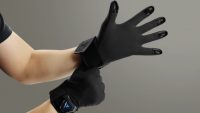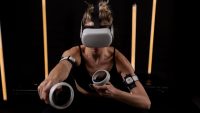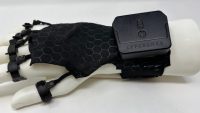CES: Haptic Technology Makes Slow Strides for CE Products
January 12, 2024
While technology for immersive visual content has (for now) settled on stereoscopic headsets with two little high-resolution screens behind two little lenses, at CES in Las Vegas this week four different developers presented four different approaches to realistic haptic feedback for arms and hands. Buzzing, squeezing and zapping are all on offer, with fundamentally different business and technology models. New haptic products from companies such as Afference, bHaptics, Valkyrie Industries and Microtube Technologies suggest we may be slowly getting closer to more physically-engaging immersive experiences.
Founded in 2015, bHaptics developed a haptic vest featuring 40 vibro-tactile motors and wireless connectivity. More than 50 SteamVR and Oculus Quest games provide support for the vest. At CES, the company presented its Bluetooth TactGlove for $299 — usable only with camera-based systems (the glove does not perform any hand tracking).

TactGlove (above) provides six points of haptic feedback per hand via linear resonant actuators that buzz your fingertips and palm, all controlled by a what the company describes as an “advanced neuromorphic algorithm.” The hype is high. The price is low. The effect is … what one would imagine, but shows promise.
The approach is to support specific game titles only, revealing the distance left to cover before generic haptic response makes the market.
Valkyrie Industries, meanwhile, demonstrated a sportsband-like device (below) worn on the upper arm with a Bluetooth receiver and a couple of electrodes. Adopting the same technology as electrical muscle stimulation (EMS) — or electromyostimulation, which is broadly accepted as an effective aid to increase muscle hypertrophy in a workout, the Valkyrie EIR will cause involuntary muscle contractions that simulate load on the biceps and triceps.

The system does not simulate either load on the wrist, or tactile feedback on the hands. It currently works only within the Meta hardware ecosystem, but Valkyrie promises compatibility with the Overwolf platform, which lets the game modding/hacking community add some kind of support to games that work with that system. No price was given during CES.
Valkyrie’s technology is less sophisticated than Afference’s Phantom (below), a wearable announced by Afference last year, and which (in their words) “hacks” the nervous system, adding extra information while your hands communicate with your brain.

Built by a team of neuroscientists, this information tricks the brain into feeling objects described by input from any properly configured software. Afference’s most obvious application is in VR, but a relatively sophisticated SDK promises integration with a variety of other tools.
The system presents in a fingerless glove, with rings around each finger. Again, the device does not do hand tracking.
Finally, Microtube Technologies from Singapore introduced its HEXR Glove (below) for $3,999 — an untethered pneumatic system which squeezes the hand in response to your actions within a Unity application (they throw in a Unity asset plugin when you purchase the glove).

This is a high resolution system capable of simulating some aspects of weight and texture; restricting freedom of movement on demand will (the developer claims) mean a decent simulation of moving the hand through a viscous medium like water or (for example) squeezing a balloon.
The different approaches demonstrate clearly how far off widespread consumer adoption is: there appears to be a high curve relating to cost to efficaciousness of the various systems; different systems have particularly polarized strengths and weaknesses (for example, Valkyrie is good at communicating weight but your hands remain ’empty,’ bHaptics is cheap but less realistic, and Microtube’s HEXR is unaffordable for consumers, but an effective approach to the problem).
There’s no common language or standard to mark up objects for haptic IO. Fascinating developments, and Afference particularly stands out as a fascinating direction with great potential — but this was not the year of haptics at CES.

No Comments Yet
You can be the first to comment!
Leave a comment
You must be logged in to post a comment.